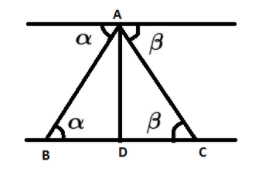
From an aeroplane vertically above a straight horizontal road, the angles of depression of two consecutive mile stones on opposite sides of the aeroplane are observed to be
Answer
431.7k+ views
Hint: Use the fact that the distance between two consecutive mile stones is one mile. The angles of depression of two consecutive milestones are given to us. Use the tan ratio for both the angles. That is, the ratio of height and base, where the height is the same for both.
Complete step-by-step answer:
Let us first draw the figure according to the question.

In the above picture A is the aeroplane, B and C are the consecutive mile stones.
We know that the distance between any two consecutive milestones is 1 mile. Therefore,
BC = 1 mile.
AD is the perpendicular from the point A on the line BC, which meets BC at the point D. Therefore the height of the aeroplane is AD.
We can write BC as the sum of BD and DC. Therefore,
The angle of depression of two consecutive milestones are
We can see that the angles B and C are alternate interior angles to angles
We also know that the tangent function is the ratio of the perpendicular and base of the triangles ADB and ADC, so here it will be the ratio of perpendicular AD, and the bases BC and CD respectively. Using this condition we will write that-
And,
Now we will put the values of (2) and (3) in equation (1). Therefore,
From the above equation we need to find out the value of AD. Therefore,
By cross multiplying,
By dividing both sides of the equation by
AD is the height of the aeroplane.
Therefore, the height in miles of the aeroplane above the road is:
Note: In this problem the distance between two consecutive mile stones plays a very important role. If we miss that point we will not be able to get the required form of height. Also, a common mistake is that the students may get confused between the formulas for the tangent and the cotangent functions, and may take perpendicular as the base, and base as the perpendicular.
Complete step-by-step answer:
Let us first draw the figure according to the question.

In the above picture A is the aeroplane, B and C are the consecutive mile stones.
We know that the distance between any two consecutive milestones is 1 mile. Therefore,
BC = 1 mile.
AD is the perpendicular from the point A on the line BC, which meets BC at the point D. Therefore the height of the aeroplane is AD.
We can write BC as the sum of BD and DC. Therefore,
The angle of depression of two consecutive milestones are
We can see that the angles B and C are alternate interior angles to angles
We also know that the tangent function is the ratio of the perpendicular and base of the triangles ADB and ADC, so here it will be the ratio of perpendicular AD, and the bases BC and CD respectively. Using this condition we will write that-
And,
Now we will put the values of (2) and (3) in equation (1). Therefore,
From the above equation we need to find out the value of AD. Therefore,
By cross multiplying,
By dividing both sides of the equation by
AD is the height of the aeroplane.
Therefore, the height in miles of the aeroplane above the road is:
Note: In this problem the distance between two consecutive mile stones plays a very important role. If we miss that point we will not be able to get the required form of height. Also, a common mistake is that the students may get confused between the formulas for the tangent and the cotangent functions, and may take perpendicular as the base, and base as the perpendicular.
Recently Updated Pages
Express the following as a fraction and simplify a class 7 maths CBSE

The length and width of a rectangle are in ratio of class 7 maths CBSE

The ratio of the income to the expenditure of a family class 7 maths CBSE

How do you write 025 million in scientific notatio class 7 maths CBSE

How do you convert 295 meters per second to kilometers class 7 maths CBSE

Write the following in Roman numerals 25819 class 7 maths CBSE

Trending doubts
Where did Netaji set up the INA headquarters A Yangon class 10 social studies CBSE

A boat goes 24 km upstream and 28 km downstream in class 10 maths CBSE

Why is there a time difference of about 5 hours between class 10 social science CBSE

The British separated Burma Myanmar from India in 1935 class 10 social science CBSE

The Equation xxx + 2 is Satisfied when x is Equal to Class 10 Maths

What are the public facilities provided by the government? Also explain each facility




